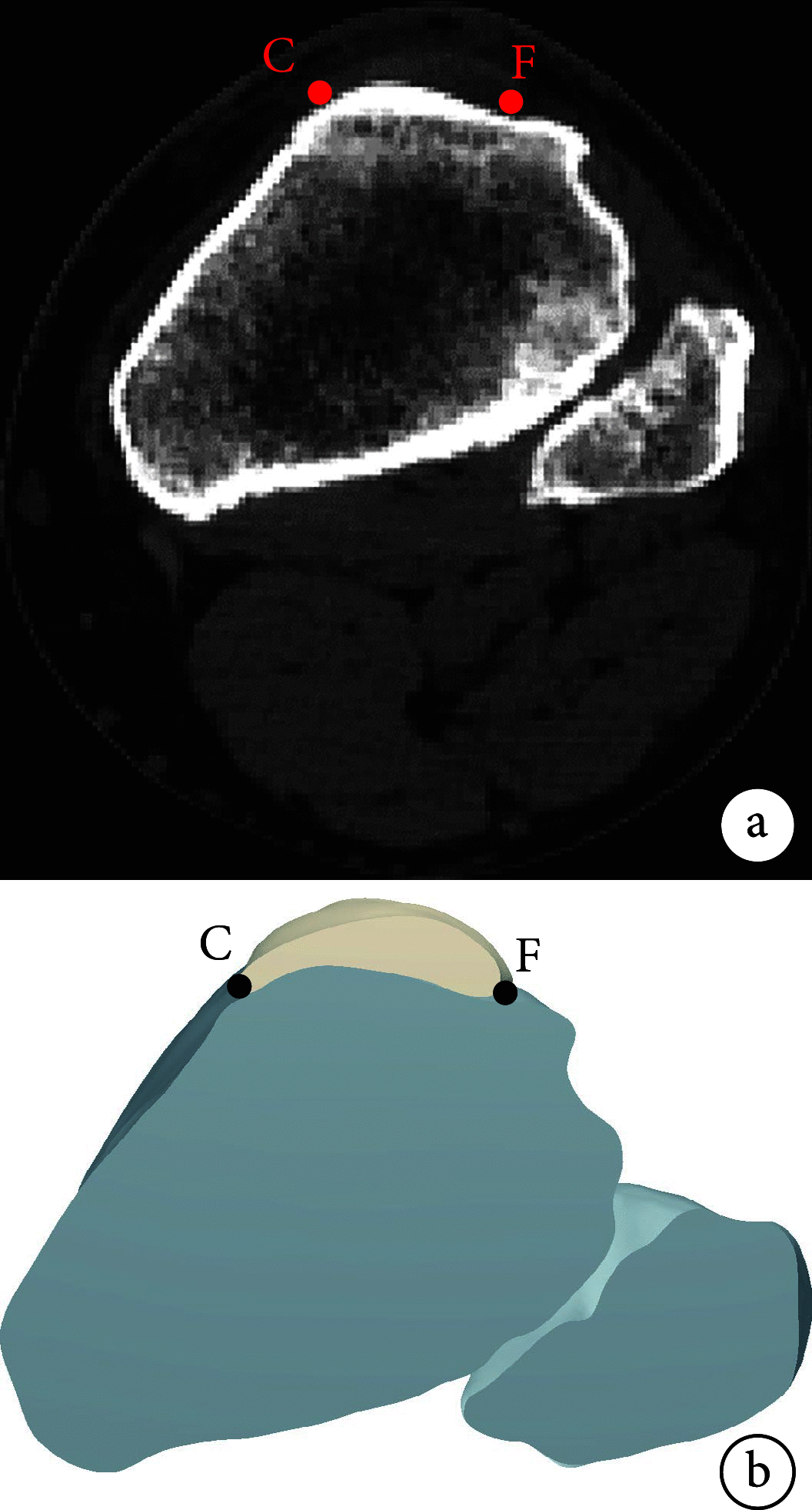[Accuracy of patellar tendon at the attachment as anatomic landmark for rotational alignment of tibial component]
- PMID: 35712930
- PMCID: PMC9240848
- DOI: 10.7507/1002-1892.202202040
[Accuracy of patellar tendon at the attachment as anatomic landmark for rotational alignment of tibial component]
Abstract
Objective: To investigate the accuracy of the modified Akagi line which referenced the patellar tendon at the attachment and the geometrical center point of the tibial osteotomy surface for tibial rotational alignment.
Methods: Between July 2021 and December 2021, 72 patients who underwent three-dimension (3D) CT for varus osteoarthritis knees were enrolled. Among 72 patients, 18 were male and 54 were female with a mean age of 64.9 years (range, 47-84 years). The preoperative hip-knee-ankle angle ranged from 0° to 26°, with a mean of 9.3°. CT images were imported into Mimics 21.0 medical image control system to establish 3D models of the knees. The prominent point of lateral epicondyle and the medial epicondylar sulcus were identified in femoral 3D models to construct the surgical transepicondylar axis and the vertical line of its projection [anteroposterior (AP) axis]. In tibial 3D models, the patellar tendon at the attachment was used as anatomical landmarks to construct rotational alignment for tibial component, including the line connecting the medial border of the patellar tendon at the attachment (C) and the middle (O) of the posterior cruciate ligament insertion (Akagi line), the line connecting the point C and the geometric center (GC) of the tibial osteotomy plane [medial border axis of the patellar tendon (MBPT)], the line connecting the medial sixth point of the patellar tendon at the attachment and the point GC [medial sixth axis of the patellar tendon (MSPT)], the line connecting the medial third point of the patellar tendon at the attachment and point O [medial third axis of the patellar tendon 1 (MTPT1)], and the line connecting the medial third point of the patellar tendon at the attachment and point GC [medial third axis of the patellar tendon 2 (MTPT2)]. The angles between the five reference axes and the AP axis were measured, and the distribution of the rotational mismatch angles with the AP axis was counted (≤3°, 3°-5°, 5°-10°, and >10°).
Results: Relative to the AP axis, the Akagi line and MBPT were internally rotated (1.6±5.9)° and (2.4±6.9)°, respectively, while MSPT, MTPT1, and MTPT2 were externally rotated (5.4±6.6)°, (7.0±5.8)°, and (11.9±6.6)°, respectively. There were significant differences in the rotational mismatch angle and its distribution between reference axes and the AP axis ( F=68.937, P<0.001; χ 2=248.144, P<0.001). The difference between Akagi line and MBPT showed no significant difference ( P=0.067), and the differences between Akagi line and MSPT, MTPT1, MTPT2 were significant ( P<0.012 5).
Conclusion: When the position of the posterior cruciate ligament insertion can not be accurately identified on total knee arthroplasty, MBPT can be used as the modified Akagi line in reference to the geometrical center point of the tibial osteotomy surface to construct a reliable rotational alignment of the tibial component.
目的: 探讨以髌韧带附着处及胫骨截骨面中心点为参考标志构建的改良型Akagi线作为胫骨假体旋转对位参考轴的准确性。.
方法: 2021年7月—12月,选择72例因膝关节骨关节炎伴内翻畸形行三维CT扫描的患者。其中男18例,女54例;年龄47~84岁,平均64.9岁。术前髋-膝-踝角0°~26°,平均9.3°。将CT图像导入交互式医学影像控制系统Mimics 21.0,建立膝关节数字化三维模型。在股骨三维模型中标记出内上髁凹和外上髁最高点的位置,构建外科通髁轴及其投影的垂线 [胫骨前后(anteroposterior,AP)轴)]。在胫骨三维模型中,以髌韧带附着处作为解剖参考标志构建胫骨假体旋转对位参考轴,包括髌韧带附着处内侧缘(C)和后交叉韧带止点中点(O)的连线(Akagi线)、胫骨截骨面中点(GC)和C点的连线 [(髌韧带内侧轴(medial border axis of the patellar tendon,MBPT)]、髌韧带附着处内侧1/6处和GC点的连线 [髌韧带内侧1/6轴(medial sixth axis of the patellar tendon,MSPT)]、髌韧带附着处内侧1/3处和O点的连线 [髌韧带内侧1/3轴1(medial third axis of the patellar tendon 1,MTPT1)] 和髌韧带附着处内侧1/3处和GC点的连线 [髌韧带内侧1/3轴2(medial third axis of the patellar tendon 2,MTPT2)]。测量5种参考轴与AP轴之间的夹角,并统计其与AP轴夹角分布情况(分为≤3°、3°~5°、5°~10°和>10°)。.
结果: Akagi线和MBPT分别相对于AP轴内旋(1.6±5.9)° 和(2.4±6.9)°,而MSPT、MTPT1和MTPT2则相对于AP轴分别外旋(5.4±6.6)°、(7.0±5.8)° 和(11.9±6.6)°。各参考轴与AP轴夹角及其分布情况差异均有统计学意义( F=68.937, P<0.001; χ 2=248.144, P<0.001)。其中Akagi线与MBPT间比较差异无统计学意义( P=0.067),与MSPT、MTPT1和MTPT2比较差异均有统计学意义( P<0.012 5)。.
结论: 当人工全膝关节置换术中无法准确辨清后交叉韧带止点位置时,可以参考胫骨截骨面中点使用MBPT作为改良型Akagi线,以构建可靠的胫骨假体旋转对位。.
Keywords: Total knee arthroplasty; rotational alignment; tibial anteroposterior axis; tibial component.
Conflict of interest statement
利益冲突 在课题研究和文章撰写过程中不存在利益冲突;经费支持没有影响文章观点和对研究数据客观结果的统计分析及其报道
Figures




Similar articles
-
Gender differences affect the location of the patellar tendon attachment site for tibial rotational alignment in total knee arthroplasty.J Orthop Surg Res. 2022 Jul 26;17(1):362. doi: 10.1186/s13018-022-03248-5. J Orthop Surg Res. 2022. PMID: 35883141 Free PMC article.
-
[Reliability of tibial anterior crest as the anatomical reference of rotating alignment for tibial component in total knee arthroplasty].Zhongguo Gu Shang. 2021 May 25;34(5):417-24. doi: 10.12200/j.issn.1003-0034.2021.05.005. Zhongguo Gu Shang. 2021. PMID: 34032042 Chinese.
-
Medial sixth of the patellar tendon at the tibial attachment is useful for the anterior reference in rotational alignment of the tibial component.Knee Surg Sports Traumatol Arthrosc. 2014 May;22(5):1070-5. doi: 10.1007/s00167-013-2468-1. Epub 2013 Mar 12. Knee Surg Sports Traumatol Arthrosc. 2014. PMID: 23479057
-
The original Akagi line is the most reliable: a systematic review of landmarks for rotational alignment of the tibial component in TKA.Knee Surg Sports Traumatol Arthrosc. 2019 Apr;27(4):1018-1027. doi: 10.1007/s00167-018-5131-z. Epub 2018 Sep 10. Knee Surg Sports Traumatol Arthrosc. 2019. PMID: 30203197
-
Radiological Approach to Assessment of Lower-Limb Alignment-Coronal and Transverse Plane Analysis.J Clin Med. 2024 Nov 19;13(22):6975. doi: 10.3390/jcm13226975. J Clin Med. 2024. PMID: 39598119 Free PMC article. Review.
References
-
- Nagamine R, Whiteside LA, White SE, et al Patellar tracking after total knee arthroplasty. The effect of tibial tray malrotation and articular surface configuration. Clin Orthop Relat Res. 1994;(304):262–271. - PubMed
-
- Nicoll D, Rowley DI Internal rotational error of the tibial component is a major cause of pain after total knee replacement. J Bone Joint Surg (Br) 2010;92(9):1238–1244. - PubMed
MeSH terms
LinkOut - more resources
Full Text Sources
Miscellaneous
